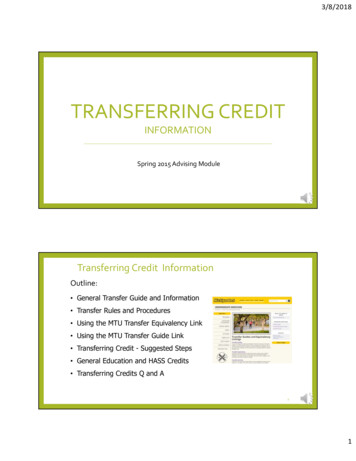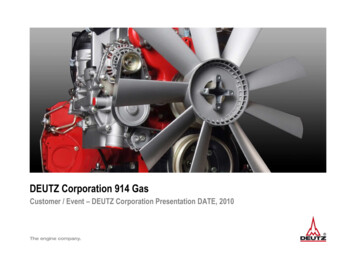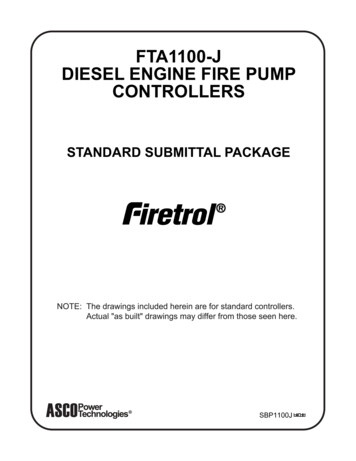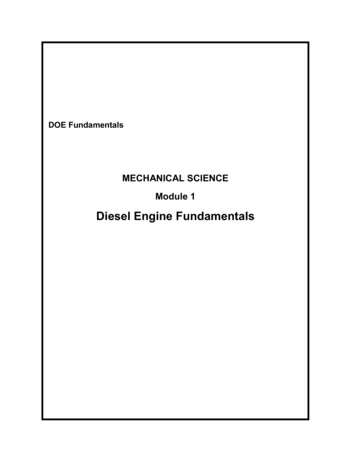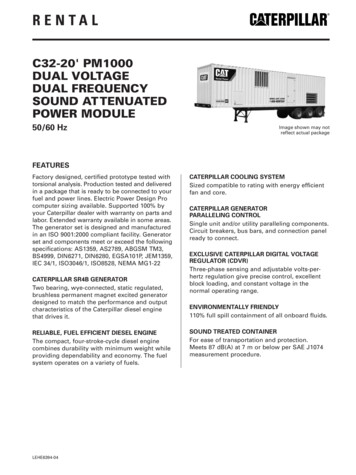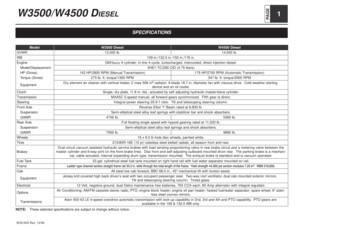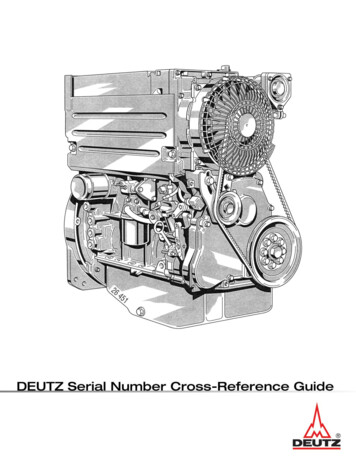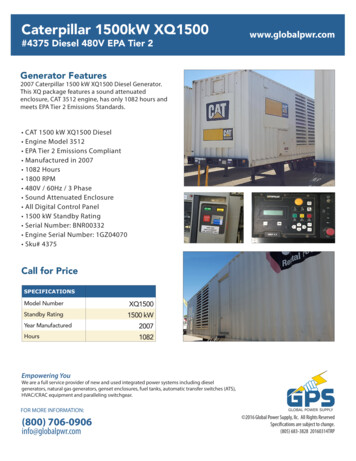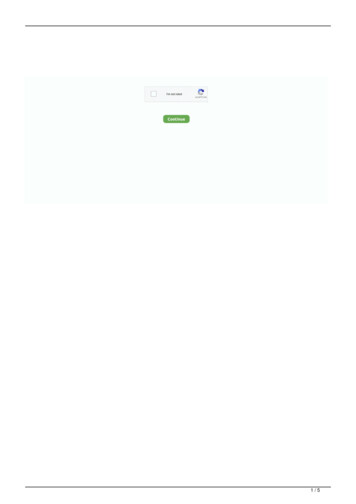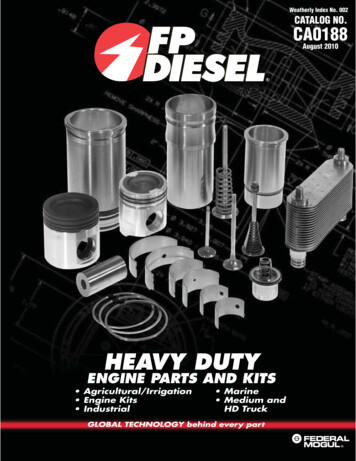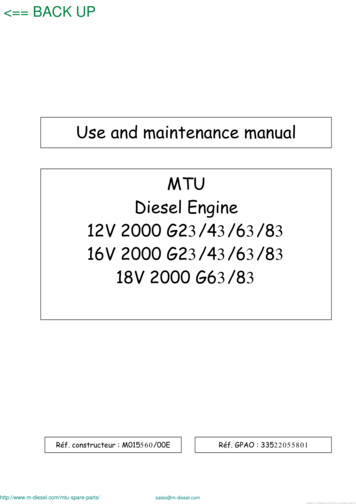
Transcription
BACK UPUse and maintenance manualMTUDiesel Engine12V 2000 G23/43/63/8316V 2000 G23/43/63/8318V 2000 G63/83Réf. constructeur : /Réf. GPAO : engine-parts/
BACK UPPrinted in Germanyã 2003 Copyright MTU Friedrichshafen GmbHDiese Veröffentlichung einschließlich aller seiner Teile ist urheberrechtlich geschützt. Jede Verwertung oder Nutzung bedarf der vorherigenschriftlichen Zustimmung der MTU Friedrichshafen GmbH. Das gilt insbesondere für Vervielfältigung, Verbreitung, Bearbeitung,Übersetzung, Mikroverfilmungen und die Einspeicherung und / oder Verarbeitung in elektronischen Systemen, einschließlich Datenbankenund Online-Diensten.Das Handbuch ist zur Vermeidung von Störungen oder Schäden beim Betrieb zu beachten und daher vom Betreiber dem jeweiligenWartungs- und Bedienungspersonal zur Verfügung zu stellen.Änderungen bleiben vorbehalten.Printed in Germanyã 2003 Copyright MTU Friedrichshafen GmbHThis Publication is protected by copyright and may not be used in any way whether in whole or in part without the prior written permission ofMTU Friedrichshafen GmbH. This restriction also applies to copyright, distribution, translation, microfilming and storage or processing onelectronic systems including data bases and online services.This handbook is provided for use by maintenance and operating personnel in order to avoid malfunctions or damage during operation.Subject to alterations and amendments.Imprimé en Allemagneã 2003 Copyright MTU Friedrichshafen GmbHTout droit réservé pour cet ouvrage dans son intégralité. Toute utilisation ou exploitation requiert au préalable l’accord écrit de MTUFriedrichshafen GmbH. Ceci s’applique notamment à la reproduction, la diffusion, la modification, la traduction, l’archivage sur microfiches,la mémorisation et / ou le traitement sur des systèmes électroniques, y compris les bases de données et les services en ligne.Le manuel devra être observé en vue d’éviter des incidents ou des endommagements pendant le service. Aussi recommandons-nous àl’exploitant de le mettre à la disposition du personnel chargé de l’entretien et de la conduite.Modifications réservées.Impreso en Alemaniaã 2003 Copyright MTU Friedrichshafen GmbHEsta publicación se encuentra protegida, en toda su extensión, por los derechos de autor. Cualquier utilización de la misma, así como sureproducción, difusión, transformación, traducción, microfilmación, grabación y/o procesamiento en sistemas electrónicos, entre los que seincluyen bancos de datos y servicios en línea, precisa de la autorización previa de MTU Friedrichshafen GmbH.El manual debe tenerse presente para evitar fallos o daños durante el servicio, y, por dicho motivo, el usario debe ponerlo a disposición delpersonal de mantenimiento y de servicio.Nos reservamos el derecho de introducir modificaciones.Stampato in Germaniaã 2003 Copyright MTU Friedrichshafen GmbHQuesta pubblicazione è protetta dal diritto d’autore in tutte le sue parti. Ciascun impiego od utilizzo, con particolare riguardo allariproduzione, alla diffusione, alla modifica, alla traduzione, all’archiviazione in microfilm ed alla memorizzazione od all’elaborazione in sistemielettronici, comprese banche dati e servizi on line, deve essere espressamente autorizzato per iscritto dalla MTU Friedrichshafen GmbH.II manuale va consultato per evitare anomalie o guasti durante il servizio, per cui va messo a disposizione dall’ utente al personale addettoalla manutenzione e alla condotta.Con riserva di s/
BACK afety, accident prevention andenvironmental protection instructions2Product SummaryEngine layout, technical data3OperationTask descriptions4Maintenance and ServicingMaintenance schedule5TroubleshootingMalfunctions, causes, measures6Task DescriptionInspection and maintenance .m-diesel.com/mtu-engine-parts/
BACK diesel.comwww.m-diesel.com/mtu-engine-parts/
BACK UPWichtig - Important – ImportanteBitte die Karte „Inbetriebnahmemeldung“ abtrennen und ausgefüllt an MTU Friedrichshafen GmbHzurücksenden.Die Informationen der Inbetriebnahmemeldung sind Grundlage für den vertraglich vereinbarten LogistikSupport (Gewährleistung, Ersatzteile etc.).Please complete and return the “Commissioning Note” card below to MTU Friedrichshafen GmbH.The Commissioning Note information serves as a basis for the contractually agreed logistic support(warranty, spare parts, etc.).Veuillez séparer la carte “Signalisation de mise en service“ et la renvoyer à la MTU FriedrichshafenGmbH.Les informations concernant la signalisation de mise en service constituent la base pour l'assistance enexploitation contractuelle (garantie, rechanges, etc.).Rogamos separen la tarjeta “Aviso de puesta en servicio“ y la devuelvan rellenada a MTUFriedrichshafen GmbH.Las informaciones respecto al aviso de puesta en servicio constituyen la base para el soporte logísticocontractual (garantía, piezas de repuesto, etc.).Staccare “Avviso di messa in servizio“ e rispedirlo debitamente compilato alla MTU FriedrichshafenGmbH.Le informazioni ivi registrate sono la base per il supporto logistico contrattuale (garanzia, ricambi, ecc.).É gentileza cortar o cartão "Participação da colocação em serviço", preenché-lo e devolvé-lo a MTUFriedrichshafen.Os dados referentes à colocação em serviço representam a base para o suporte logístico (garantia, peçassobressalentes, etc.) estabelecido parts/PostcardMTU Friedrichshafen GmbHDepartment SCSD88040 el.com/mtu-engine-parts/
BACK UPBitte in Blockschrift ausfüllen!Please use block capitals!Prière de remplir en lettres capitales!¡A rellenar en letras de imprenta!Scrivere in stampatello!Favor preencher com letras de forma!Motornr.:Engine No.:No du moteur:No de motor:Motore N.:No. do motor:Auftragsnr.:MTU works order No.:No de commande:No de pedido:N. commessa:No. do pedido:Motortyp:Engine model:Type du moteur:Tipo de motor:Motore tipo:Tipo do motor:Inbetriebnahmedatum:Date put into operation:Mise en service le:Fecha de puesta en servicio:Messa in servizio il:Data da colocação em serviço:Eingebaut in:Installation site:Lieu de montage:Lugar de montaje:Installato:Incorporado em:Schiffstyp / Schiffshersteller:Vessel/type/class / Shipyard:Type du bateau / Constructeur:Tipo de bugue / Constructor:Tipo di Barca / CostruttoreTipo de embarcação/estaleiro naval:InbetriebnahmemeldungCommissioning NoteNotice de mise en serviceAviso de puesta en servicioAvviso di messa in servizioParticipação da colocaçãoem serviçoEndabnehmer/Anschrift:End user s address:Adresse du client final:Dirección del cliente final:Indirizzo del cliente finale:Usuário l.com/mtu-engine-parts/
BACK UPAmendment Service!Any changes in contents will be sent to you in the form of an amendment,provided you complete the reverse of this receipt card and return it to dMTU Friedrichshafen GmbHDepartment SCT88040 el.com/mtu-engine-parts/
BACK UPNo.Please mark all filed amendments 6.Please use block capitals!ReceiptAmendment No.1.2.3.4.Publication number: M015560/00E5.6.Name.Manufacturer .7.8.9.Department .10.Fax.Telephone.11.Street.12.Postal box number .13.14.(Postal code) City parts/
BACK UPTable of Contents11–ISafety1.1 General conditions.1.2 Personnel and organizational requirements1 – 01.1 – 021.3 Transport . . . . . . . . . . . . . . . . . . . . . . . . . . . . . . . . . . . . . . . . . . . . . . . . . . . . . . . . . . . . . . . . .1 – 031.4 Safety precautions when working on the engine . . . . . . . . . . . . . . . . . . . . . . . . . . . . . . . . .1 – 041.5 Auxiliary materials, fire prevention and environmental protection.1 – 07.1 – 091.6 Standards for warning notices in the /mtu-spare-parts/ arts/
BACK UP1 – IIM015560/00ETable of ts/ arts/
BACK UPSafety1.11 – 01General conditionsGeneralIn addition to the instructions in this publication, the applicable country-specific legislation and other compulsoryregulations regarding accident prevention must be observed. This engine is a state-of-the art product and conformswith all applicable specifications and regulations. Nevertheless, persons and property may be at risk in the event of: Incorrect use Operation, maintenance and repair by unqualified personnel Modifications or conversions Non-compliance with the Safety InstructionsCorrect useThe engine is intended exclusively for the application specified in the contract or defined at the timeof delivery. Any other use is considered improper use. The manufacturer will accept no liability forany resultant damage. The responsibility is borne by the user alone.Correct use also includes observation of and compliance with the maintenance specifications.Modifications or ConversionsModifications made by the customer to the engine may affect safety.MTU will accept no liability or warranty claims for any damage caused by unauthorized modifications or conversions.Spare partsOnly genuine MTU spare parts must be used to replace components or assemblies. In theevent of any damage caused by the use of other spare parts, no liability nor warranty claimsvis-à-vis the engine manufacturer will be tu-spare-parts/ arts/
BACK UP1 – 021.2SafetyPersonnel and organizational requirementsPersonnelWork on the engine must only be carried out by properly qualified and instructed personnel.The specified legal minimum age must be observed.Responsibilities of the operating, maintenance and repair personnel must be specified.OrganizationThis publication must be issued to all personnel involved in operation, maintenance, repair or transportation.It must be kept at hand near the engine and accessible at any time to all personnel involvedin operation, maintenance, repair or transportation.The personnel must be instructed on engine operation and repair by means of this publication,and in particular the safety instructions must be explained.This is especially important for personnel who work on the engine only on an occasional basis.Such personnel must be given instructions repeatedly.Working clothes and protective equipmentWear proper work clothing for all work.Depending on the kind of work, use additional protective equipment, e.g. protective goggles, gloves, helmet, apron.Work clothing must be tight fitting so that it does not catch on rotating or projecting components.Do not wear jewelry (e.g. rings, chains spare-parts/ arts/
BACK UPSafety1.31 – 03TransportTransportLift the engine only with the lifting eyes provided.Use only the transport and lifting equipment approved by MTU.Take note of the engine center of gravity.The engine must only be transported in installation position, max. permissible diagonal pull 10 .In the case of special packaging with aluminum foil, suspend the engine on the lifting eyes of thetransport pallet or transport with equipment for heavy loads (forklift truck).Prior to transporting the engine, it is imperative to install transportation lockingdevices for crankshaft and engine mounts.Secure the engine against tilting during transport. The engine must be especially secured againstslipping or tilting when going up or down inclines and ramps.Setting the engine down after transportPlace the engine only on an even, firm surface.Ensure appropriate consistency and load-bearing capacity of the ground or support surface.Never place an engine on the oil pan, unless expressively authorized by MTU on a case-to-case basis to do re-parts/ arts/
BACK UP1 – 041.4SafetySafety precautions when working on the engineEngine operationWhen the engine is running, always wear ear protectors.Ensure that the engine room is well ventilated.Mop up any leaked or spilt fluids and lubricants immediately or soak up with a suitable bonding agent.Exhaust gases from combustion engines are poisonous. Inhalation of poisonous exhaust gases is a healthhazard. The exhaust pipework must be free of leaks and discharge the gases to atmosphere.During engine operation, do not touch battery terminals, generator terminals or cables.Inadequate protection of electrical components can lead to electric shocks and serious injuries.When the engine is running, never release coolant, oil, fuel, compressed-air or hydraulic lines.Maintenance and repairCompliance with maintenance and repair specifications is an important safety factor.Unless expressly permitted, no maintenance or repair work must be carried out with the engine running. Securethe engine against inadvertent starting. With electric starter, disconnect the battery. With pneumatic starter, closemain shut-off valve of compressed-air system and release pressure from compressed-air supply line. Attach sign"Do not operate" in operating area or to control equipment. Persons not involved must keep clear.Never attempt to rectify faults or carry out repairs if you do not have the necessary experience or special toolsrequired. Maintenance and repair work must only be carried out by authorized, qualified personnel.Use only proper, calibrated tools.Do not work on engines or components which are only held by lifting equipment or crane.Always support these components in accordance with regulations on suitable frames or standsbefore beginning any maintenance or repair work.Before barring the engine, make sure that nobody is standing in the danger zone. After working on the engine, checkthat all guards have been reinstalled and that all tools and loose components have been removed from the engine.Fluids emerging under high pressure can penetrate clothing and skin and may cause serious injury. Beforestarting work, relieve pressure in systems and H.P. lines which are to be opened.Never bend a fuel line and do not install bent lines. Keep fuel injection lines and connections clean.Always seal connections with caps or covers if a line is removed or opened.During maintenance and repair work, take care not to damage the fuel lines. To tighten the connections wheninstalling the lines, use the correct tightening torque and ensure that all retainers and dampers are installed correctly.Ensure that all fuel injection lines and pressurized oil lines have sufficient distance to othercomponents to avoid contact with them. Do not place fuel or oil lines near hot components,except when necessary for design reasons during installation.Elastomers (e.g. "Viton" sealing rings) are stable under normal operating conditions. When subjectedto fire or temperatures above 300 C the material degenerates, giving off hydrogen fluoride gas. Theresulting acid leads to serious burning if it contacts the skin. Do not touch elastomeric seals if theyhave carbonized or resinous appearance. Wear protective gloves!Take care with hot fluids in lines, pipes and chambers Risk of injury!Note cooling period for components which are heated for installation or removal Risk of injury!Do not touch hot components of the compressor and the exhaust system Risk of injury!Take special care when removing ventilation or plugs from engine. In order to avoid discharge ofhighly pressurized liquids, hold a cloth over the screw or plug. It is even more dangerous if theengine has recently been shut down, as the liquids can still be hot.Take special care when draining hot fluids. Risk of injury!When draining, collect fluids in a suitable container, mop up any spilt fluids or wipe orsoak them with a suitable bonding agent.When changing the engine oil or working on the fuel system, ensure that the engine room is adequately ventilated.When working high on the engine, always use suitable ladders and work platforms. Makesure components are placed on stable surfaces.In order to prevent back injuries when lifting heavy components adults, depending on age and sex,should only lift weights between max. 10 kg and 30 kg, therefore: Use lifting gear or seek /mtu-spare-parts/ arts/
BACK UPSafety1 – 05 Ensure that all chains, hooks, slings, etc. are tested and authorized, are sufficiently strong and thathooks are correctly positioned. Lifting eyes must not be unevenly loaded.Welding workNever carry out welding work on the engine or engine-mounted units.Never use the engine as a ground connection. (This prevents the welding current passingthrough the engine and causing scoring or burning at bearings, sliding surfaces and toothflanks, which can lead to pitting or other material damage).Never position the welding power supply cable adjacent to, or crossing MTU plant wiring harnesses. (The weldingcurrent could be induced in the cable harnesses and could possibly damage the electrical plant).The welding unit ground connection must not be more than 60 cm from the weld point.If components (e.g. exhaust manifold) are to be welded, they must be removed from the engine.It is not necessary to remove the connector and the connections when carrying out welding operationon MTU electronics if the master switch for power supply is switched from "ON" to "OFF" and the wireis disconnected from the negative and positive poles on the battery.Hydraulic installation and removalOnly the hydraulic installation and removal equipment specified in the work schedule andin the assembly instructions must be used.The max. permissible push-on pressure specified for the equipment must not be exceeded.The H.P. lines for hydraulic installation and removal are tested with 3800 bar.Do not attempt to bend or apply force to lines.Before starting work, pay attention to the following: Vent the hydraulic installation/removal tool, the pumps and the lines at the relevant points for the system tobe used (e.g. open vent plugs, pump until bubble-free air emerges, close vent plugs). For hydraulic installation, screw on the tool with the piston retracted. For hydraulic removal, screw on the tool with the piston extended.For a hydraulic installation/removal tool with central expansion pressure supply, screw spindleinto shaft end until correct sealing is achieved.During hydraulic installation and removal, ensure that nobody is standing in the immediate vicinity of thecomponent to be installed/removed. As long as the system is under pressure, there is the risk that thecomponent to be installed/removed may be suddenly released from the pressure connection.Before use, the tools must be checked at regular intervals (crack test).Working on electrical/electronic assembliesAuthorization must be obtained from the superior prior to commencing maintenance and repair workand switching off parts of the electronic system required for this.Prior to working on assemblies, the power of the appropriate areas must be switched off. Any measuresrequiring power supply are expressly defined as such at the appropriate place in the manual.Gases released from the battery are explosive. Avoid sparks and naked flames. Do not allow batteryacids to come in contact with skin or clothing. Wear protective goggles. Do not place tools on thebattery. Before connecting the cable to the battery, check battery polarity. Battery pole reversal may leadto injury through the sudden discharge of acid or bursting of the battery body.Do not damage wiring during removal work and when reinstalling wiring and ensure that during operation it isnot damaged by contact with sharp objects, by rubbing against other component or by a hot surface.Do not secure wiring to fluid-carrying lines.On completion of the maintenance and repair work, any cables which have become loosemust be correctly connected and secured.Always tighten connectors with connector pliers.On completion of all repair work, the component and system must be subjected to a function check.Separate testing of the repaired component without system integration is insufficient.If wires are installed beside mechanical components and there is a risk of chafing, usecable clamps to properly support the wires.For this purpose, no cable binders must be used as, during maintenance and / or repair work,the binders can be removed but not installed a second pare-parts/ arts/
BACK UP1 – 06SafetySpare parts shall be properly stored prior to replacement, i.e. particularly protected against moisture. Defectiveelectronic components and assemblies must be suitably packed when dispatched for repair, i.e. particularlyprotected against moisture and impact and wrapped in antistatic foil if necessary.Working with laser equipmentWhen working with laser equipment, always wear special laser-protection goggles.Laser equipment can generate extremely intensive, concentrated radiation by the effect of stimulated emissionin the range of visible light or in the infrared or ultraviolet spectral range. The photochemical, thermal andoptomechanical effects of the laser can cause damage. The main danger is irreparable damage to the eyes.Laser equipment must be fitted with the protective devices necessary for safeoperation according to type and application.For conducting light-beam procedures and measurement work, only the following laser devices must be used: Laser devices of classes 1, 2 or 3A, Laser devices of class 3B, which have maximum output in the visible wavelength range (400 to 700 nm), amaximum output of 5 mW, and in which the beam axis and surface are designed to prevent any risk to the eyes.Operation of electrical equipmentWhen operating electrical equipment, certain components of this equipment are live.Noncompliance with the warning instructions given for this equipment may resultin serious injury or damage to tu-spare-parts/ arts/
BACK UPSafety1.51 – 07Auxiliary materials, fire prevention and environmentalprotectionFire preventionRectify any fuel or oil leaks immediately; even splashes of oil or fuel on hot components can cause fires therefore always keep the engine in a clean condition. Do not leave cloths soaked with fluids and lubricantslying around on the engine. Do not store combustible fluids near the engine.Do not weld pipes and components carrying oil or fuel. Before welding, clean with an inflammable fluid.When starting the engine with a foreign power source, connect the ground lead last and remove it first.To avoid sparks in the vicinity of the battery, connect the ground lead from the foreign power sourceto the ground lead of the engine or to the ground terminal of the starter.Always keep suitable fire-fighting equipment (fire extinguishers) at hand and familiarize yourself with their use.NoiseNoise can lead to an increased risk of accident if acoustic signals, warning shouts ornoises indicating danger are drowned.At all workplaces with a sound pressure level over 85 dB (A), always wear ear protectors(protective wadding, plugs or capsules).Environmental protectionDispose of used fluids, lubricants and filters in accordance with local regulations.Manipulation of the injection control system can influence the engine performance and exhaust emissions.As a result, compliance with environmental regulations may no longer be guaranteed.Only fuels of the specified quality required to achieve emission limits must be used.In Germany, the VAwS ( regulations governing the use of materials that may affect water quality) is applicable,which means work must only be carried out by authorized specialist companies (MTU is such a company).Auxiliary materialsUse only fluids and lubricants that have been tested and approved by MTU.Fluids and lubricants must be kept in suitable, properly designated containers. When using fluids, lubricants andother chemical substances, follow the safety instructions applicable to the product. Take care when handlinghot, chilled or caustic materials. When using inflammable materials, avoid sparks and do not smoke.Lead When working with lead or lead-containing pastes, avoid direct contact to the skin and do not inhale lead vapors. Adopt suitable measures to avoid the formation of lead dust! Switch on fume extraction system. After coming into contact with lead or lead-containing materials, wash hands!Acids and alkaline solutions When working with acids and alkalis, wear protective goggles or face mask, gloves and protective clothing. Immediately remove clothing wetted by acids and alkalis! Rinse injuries with plenty of water! Rinse eyes immediately with eyedrops or clean tap water.Paints When painting in other than spray booths equipped with extractors, ensure good ventilation.Make sure that adjacent work areas are not affected. No naked flame! No smoking. Observe fire prevention regulations! It is absolutely necessary to wear masks providing protection against paint and solvent fumes.Liquid oxygen Liquid oxygen is highly inflammable. Liquid oxygen should only be stored in small quantities and in regulation containers (without fixed seals)! Do not bring liquid oxygen in contact with the body (hands), as this causes frostbite and possibly the loss of tissue. No smoking, no naked flame, risk of explosion! Excessive oxygen in the air leads to explosive /mtu-spare-parts/ arts/
BACK UP1 – 08Safety Do not store combustible substances, e.g. oils and greases, within 5 m of the working area! Under no circumstances should clothing be oily or greasy. Do not allow vapors to penetrate clothing! Oxygen enrichment in fabric can causeworking clothes to ignite suddenly! After working with liquid oxygen, do not smoke until clothing is free of vapors! Avoid all knocks and jars to the containers, fixtures or workpieces.Liquid nitrogen Store liquid nitrogen only in small quantities and always in regulation containers without fixed covers. Do not bring liquid nitrogen in contact with the body (eyes, hands), as this causes frostbite and numbing. Wear protective clothing, including gloves and closed shoes, and protective goggles! Ensure that the room is well ventilated. Nitrogen concentration exceeding 88% ofbreathing air leads to suffocation. Avoid all knocks and jars to the containers, fixtures or workpieces.Compressed airCompressed air is air compressed at excess pressure and is stored in tanks from which it can be extracted.The pressure at which the air is kept can be read off at pressure gauges which must be connectedto the compressed air tanks and the compressed air lines.When working with compressed air, safety precautions must be constantly observed: Pay special attention to the pressure level in the compressed air network and pressure vessel! Connecting devices and equipment must either be designed for this pressure or, if the permittedpressure for the connecting elements is lower than the pressure required, a pressure reducingvalve and safety valve (set to permitted pressure) must form an intermediate connection. Hosecoupling and connections must be securely attached! Always wear protective goggles when blowing off tools or extracting chips! The snout of the air nozzle is provided with a protective disc (e.g. rubber disc), which preventsair-borne particles being reflected and thereby prevents injury to eyes. First shut off compressed air lines before compressed air equipment is disconnected from thesupply line or before equipment or tool is to be replaced! Unauthorized use of compressed air, e.g. forcing flammable liquids (danger class AI, AIIand B) out of containers, results in a risk of explosion! Forcing compressed air into thin-walled containers (e.g. containers made of tin, plastic and glass)for drying purposes or to check for leaks, results in a risk of explosion! Do not blow dirty clothing with compressed air when being worn on the body.Used oilUsed oil may contain health-threatening combustion residues.Rub barrier cream into hands!Wash hands after contact with used are-parts/ arts/
BACK UPSafety1.61 – 09Standards for warning notices in the publicationIn
Lift the engine only with the lifting eyes provided. Use only the transport and lifting equipment approved by MTU. Take note of the engine center of gravity. The engine must only be transported in installation position, max. permissible diagonal pull 10 . In the case of special packaging with aluminum foil, suspend the engine on the lifting .
